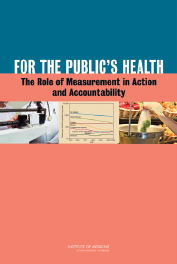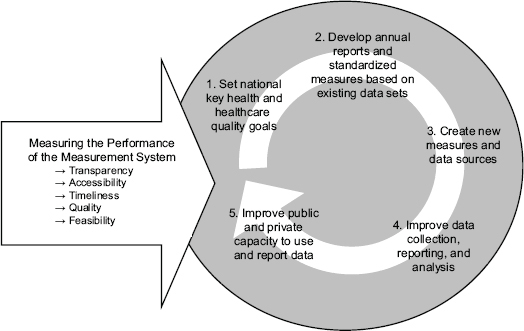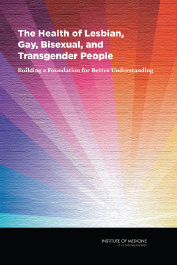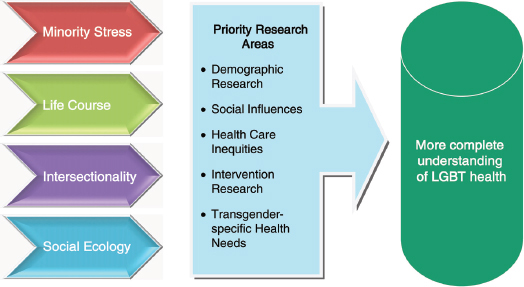Healthcare programs and policies depend on timely, accurate, and thorough information. Yet the nation’s systems to collect and analyze key health data fall short of their potential. The Institute of Medicine (IOM) has conducted a number of studies in recent years to guide collection and analysis of health information. How healthy is the population as a whole, or subgroups within the population? What measures provide the best indicators of health, for individuals and society? The answers to such questions hold the key to judging performance and improving the health of all Americans.
Health and the nation
America has the costliest healthcare system in the world, but many countries get better results for less money. Recent international comparisons show that dozens of less affluent nations boast higher life expectancy and lower infant mortality than the United States.
Looking beyond such statistics, the Robert Wood Johnson Foundation saw a more fundamental problem: the nation lacks a comprehensive system for gathering, analyzing, and communicating health information about the population. The foundation turned to the IOM for guidance on filling this gap, commissioning a 2.5-year study on three key aspects of public health—measurement, laws, and funding.
In its first report, For the Public’s Health: The Role of Measurement in Action and Accountability (2010), the committee concluded that social and environmental factors, rather than delivery of clinical care, are the most powerful shapers of health outcomes in the population, yet the nation lacks a cohesive strategy and measurement tools for tracking and responding
to these critical influences. For example, health outcomes now are listed under categories such as “infant mortality” or “myocardial infarction,” but the environmental or social failures—as when community residents lack easy access to healthful foods or to safe sidewalks and parks for exercise—that could have mitigated these conditions are less obvious and therefore go unnoticed. These nonmedical factors are not routinely measured, so harmful trends and disparities often go unrecorded.

Achieving gains in the nation’s health will require actions across many domains, including communities and their organizations, the clinical care delivery system, employers and businesses, the media, and other public and private stakeholders whose policies and actions affect the longevity and quality of life of every person. In a detailed roadmap for the nation, this report describes needed changes in the processes and tools used to gather information about health outcomes and their determinants and shows how such measures can be used to assess and enhance accountability on the part of governmental and other entities that bear responsibility for the population’s health.
The report urges the Department of Health and Human Services (HHS) to lead development of one core set of standardized indicators focused on priority health outcomes. The numerous health indicator sets developed in recent years and deployed in different contexts make assessment and comparison difficult for policy makers and other decision makers by highlighting similar information in different ways. The standard indicators should reflect national, state, and local priorities and enable an “apples to apples” comparison of jurisdictions.
America has the costliest healthcare system in the world, but many countries get better results for less money.
HHS also should develop and promote a single summary measure of population health to serve as an equivalent to the gross domestic product in the economic sector. This measure could be used to track trends, mark progress, and encapsulate an overall picture of the health of communities and the nation, improving the ability of decision makers to monitor health status, make forecasts, and set priorities. In addi-
tion, HHS should issue an annual report on the social and environmental factors that influence the population’s health as a means of helping Americans better understand what shapes their well-being at the local, state, and national levels. A report of this kind potentially could galvanize actions that lead to better outcomes and could increase the likelihood that health implications be considered not only in health policy but in all policy.
The committee’s second report, For the Public’s Health: Revitalizing Law and Policy to Meet New Challenges, describes how public policy can more effectively protect and improve the health of the population. This report is described later in the chapter on public health. In its third report, expected late in 2011, the committee will propose recommendations for funding state and local public health systems within the healthcare landscape expected to evolve as the Affordable Care Act of 2010 is implemented.
Working in concert with HHS, the IOM helped to develop and promote a new national Health Data Initiative (HDI). Described in more detail in the chapter on IOM’s collaborations, the HDI is an effort to make use of health data to raise awareness and spark community action to improve health.
National health indicators
Improving health measurement stands at the center of a major HHS program to chart the health of the nation’s population. For the past three decades, HHS has issued a national agenda aimed at improving the health of all Americans over each 10-year span. Under each of these Healthy People initiatives, HHS established health targets and monitored how well people were reaching them over time. Healthy People 2020 lays out the proposed agenda for the current decade. At the request of HHS, the IOM convened a committee of experts to review the agenda and recommend ways to sharpen its focus.
Healthy People 2020, like previous versions, lays out a number of topics and objectives that collectively provide a blueprint for improving the nation’s health. In the context of the Healthy People blueprints, a topic is a general category relevant to health (such as chronic illness), and an objective is movement toward a quantitative health goal (such as reducing the prevalence of cardiovascular disease by 10 percent). With the steady advance of science and medicine, each decade’s agenda has grown increasingly detailed. Healthy People 2020 lists 42 topics and nearly
Topics, Indicators, and Objectives
| Topics | Indicators | Objectives |
| Access to Care | Proportion of the population with access to healthcare services |
1. Increase the proportion of persons with health insurance (AHS 1). 2. Increase proportion of persons with a usual primary care provider (AHS 3). (Developmental) 3. Increase the proportion of persons who receive appropriate evidence-based clinical preventive services (AHS 7). |
| Healthy Behaviors | Proportion of the population engaged in healthy behaviors |
4. Increase the proportion of adults who meet current federal physical activity guidelines for aerobic physical activity and for muscle-strengthening activity (PA 2). 5. Reduce the proportion of children and adolescents who are considered obese (NWS 10). 6. Reduce consumption of calories from solid fats and added sugars in the population aged 2 years and older (NWS 17). 7. Increase the proportion of adults who get sufficient sleep (SH 4). |
| Chronic Disease | Prevalence and mortality of chronic disease |
8. Reduce coronary heart disease deaths (HDS 2). 9. Reduce the proportion of persons in the population with hypertension (HDS 5). 10. Reduce the overall cancer death rate (C 1). |
| Environmental Determinants | Proportion of the population experiencing a healthy physical environment |
11. Reduce the number of days the Air Quality Index (AQI) exceeds 100 (EH 1). |
| Social Determinants | Proportion of the population experiencing a healthy social environment |
12. (Developmental) Improve the health literacy of the population (HC/HIT 1). 13.(Developmental) Increase the proportion of children who are ready for school in all five domains of healthy development: physical development, social-emotional development, approaches to learning, language, and cognitive development (EMC 1). 14. Increase educational achievement of adolescents and young adults (AH 5). |
| Injury | Proportion of the population that experiences injury |
15. Reduce fatal and nonfatal injuries (IVP 1). |
| Mental Health | Proportion of the population experiencing positive mental health |
16. Reduce the proportion of persons who experience major depressive episodes (MDE) (MHMD 4). |
| Maternal and Infant Health | Proportion of healthy births |
17. Reduce low birth weight (LBW) and very low birth weight (VLBW) (MICH 8). |
| Responsible Sexual Behavior | Proportion of the population engaged in responsible sexual behavior |
18. Reduce pregnancy rates among adolescent females (FP 8). 19. Increase the proportion of sexually active persons who use condoms (HIV 17). |
| Substance Abuse | Proportion of the population engaged in substance abuse |
20. Reduce past-month use of illicit substances (SA 13). 21. Reduce the proportion of persons engaging in binge drinking of alcoholic beverages (SA 14). |
| Tobacco | Proportion of the population using tobacco |
22. Reduce tobacco use by adults (TU 1). 23. Reduce the initiation of tobacco use among children, adolescents, and young adults (TU 3). |
| Quality of Care | Proportion of the population receiving quality healthcare services |
24. Reduce central line-associated bloodstream infections (CLABSI) (HA 1). |
NOTE: The numbering of the objectives is directly from Healthy People 2020.
SOURCE: Leading Health Indicators for Healthy People 2020: Letter Report, p. 6.
600 objectives. By comparison, Healthy People 2000 listed 15 topics and 226 objectives.
As part of its charge, the IOM committee was asked to identify 12 key topics and 24 objectives that are critical to the nation’s health needs, and also to identify 24 leading indicators, or measurements of health-related concepts, that reflect major public health concerns. The committee presented its recommendations in Leading Health Indicators for Healthy People 2020: Letter Report (2011).
The committee arrived at its recommendations by using, among other things, a life-course health model that takes into account specific risk factors and determinants of health that mark various stages of life and combines them to produce a health trajectory that spans a person’s lifetime. The trajectory can be improved by reducing risk factors and promoting health through actions at both individual and society levels, applied at specific points or during specific stages of the life course, especially during the early years of life. In choosing its recommended objectives, the committee applied additional criteria. For example, the objectives should be actionable—that is, responsive to policies or initiatives by public or private health agencies. They also should be based on the latest scientific evidence and, to the extent possible, should have annual data sources, with comparable data available at the state and county level.
Improving health measurement stands at the center of a major Health and Human Services program to chart the health of the nation’s population.
Overall, the committee concludes that Healthy People 2020 is likely to prove valuable in eliciting interest and awareness among the general population, motivating diverse population groups to engage in activities that will improve their health, and providing feedback on progress toward improvements on specific health indicators. Advances in these areas will help the nation achieve health equity and eliminate disparities; create social and physical environments that promote good health; and promote quality of life, healthy development, and healthy behaviors across life stages.
Measuring health among understudied populations
Information gaps also occur among subgroups within the larger U.S. population, including among children and adolescents. In the Children’s Health Insurance Program Reauthorization Act of 2009, Congress directed the
IOM and the National Research Council to convene an expert committee to evaluate current efforts to measure child and adolescent health and the quality of their healthcare services.
The committee found that despite federal support for hundreds of data sets and measures through federal surveys and administrative data systems, the nation lacks robust national- and state-level information about the health status or healthcare quality of children and adolescents. In its report, Child and Adolescent Health and Health Care Quality: Measuring What Matters (2011), the committee pointed to a lack of standardized data in key areas—such as race and ethnicity, socioeconomic status, primary language spoken at home, and parental English proficiency—and said these information gaps hinder policy makers, researchers, and others who use data to identify, monitor, and resolve persistent health and healthcare quality disparities among children and adolescents. Measurement in these areas is especially important given the growing ethnic and racial diversity of children and adolescents and the increasing number of children who live in poverty.
The nation lacks robust national- and state-level information about the health status or healthcare quality of children and adolescents.
To guide improvements, the committee recommended the following five-step action plan:
1. Set shared health and healthcare quality goals for children and adolescents.
2. Develop annual reports and standardized measures for existing data sets of health and healthcare quality that can be collected and used to assess progress toward those goals.
3. Create new measures and data sources in priority areas.
4. Improve methods for data collection, reporting, and analysis.
5. Improve public and private capacities to use and report data.
This approach will require both government-funded and private initiatives and should include continuous evaluation of the measurement system itself for transparency, accessibility, timeliness, quality, and feasibility.
Within this framework, the report calls for adopting a “life-course” approach to measurement that considers how events at each stage of life influence subsequent health and healthcare quality. The approach places
greater emphasis on social, behavioral, and physical factors that influence the health status of children and adolescents and their use of healthcare services. The approach focuses on the needs of the “whole child” as opposed to individual clinical concerns, and will better meet the distinct needs of younger populations, including their unique patterns of morbidity and mortality, their dependent status, and their developmental stages.
The committee also endorsed the use of innovative measurement practices that can adapt to changing conditions, changing populations, and opportunities for health improvement. This will require efforts that track key child and adolescent populations over time to ensure that groups with the greatest risk for poor outcomes are included in data sources. Electronic data collection—done in ways that ensure privacy and confidentiality—offers opportunities to enhance future measurement activity by capturing important state-level policy and community-level characteristics and enabling analysis of the variability and impact of coverage, eligibility, and payment policies.

A stepwise approach to measuring health and healthcare quality for children and adolescents.
SOURCE: Child and Adolescent Health and Health Care Quality: Measuring What Matters, p. 185.
In another study, the IOM considered the health status and health needs of a population subgroup that historically has been overlooked—lesbian, gay, bisexual, and transgender individuals, often referred to under the umbrella acronym LGBT. Even as LGBT people are becoming more socially acknowledged, clinicians and researchers are faced with incomplete information about their health status. In this light, the National Institutes of Health (NIH) asked the IOM to appoint an expert committee to assess current knowledge of the health of LGBT populations, identify research shortcomings and opportunities, and outline an agenda to help the NIH focus its research in this area.
Even as lesbian, gay, bisexual, and transgender people are becoming more socially acknowledged, clinicians and researchers are faced with incomplete information about their health status.
In The Health of Lesbian, Gay, Bisexual, and Transgender People: Building a Foundation for Better Understanding (2011), the committee identifies a number of challenges that researchers face in understanding the health needs of LGBT populations, including a lack of data. To correct this, the committee recommended that HHS and other federal agencies use their health surveys to collect data on sexual orientation and gender identity, in the same way that race and ethnicity data are collected. In June 2011, a few months after the report’s release, HHS Secretary Kathleen Sebelius announced plans to begin collecting health data on LGBT populations in an effort to help researchers, policy makers, health providers, and advocates to identify and eliminate health disparities afflicting these communities.

In addition, the report recommends that questions about sexual orientation and gender identity be standardized to allow for the comparison and combination of data across large studies. Such data should be collected as well in electronic health records in various settings, with appropriate privacy and security protections.
The committee also urges the NIH to avoid repeating past disparities in research, which has not been conducted evenly across sexual and gender minority populations. More research has focused on gay men and lesbians
than on bisexual and transgender people, for example, and research has not adequately examined subpopulations, particularly racial and ethnic groups. Also, most research has been conducted among adults, with a modest number of studies on adolescents and less attention on LGBT elders.
In its recommended research agenda for the NIH, the committee focuses on five priority areas: demographic research, social influences, healthcare inequities, intervention research, and transgender-specific health needs. The NIH also should support methodological research aimed at developing innovative ways to conduct research with small populations—to reduce the costs of such research—and determining the best ways to collect information on sexual and gender minorities in research, health care, and other settings.
To encourage more research on LGBT health issues, the NIH should create a comprehensive research training program that would raise awareness of LGBT health issues among researchers. The NIH also should encourage researchers in a range of institutions to include sexual and gender minorities explicitly in their samples, using the NIH policy on the inclusion of women and racial and ethnic minorities in clinical research as a model. This would prompt researchers to consider these groups more frequently when applying for research grants and ultimately increase the body of information on the health status and needs of LGBT populations.

Research agenda.
SOURCE: The Health of Lesbian, Gay, Bisexual, and Transgender People: Building a Foundation for Better Understanding, p. 6.










